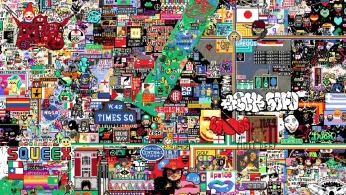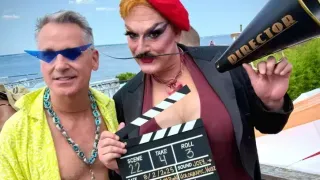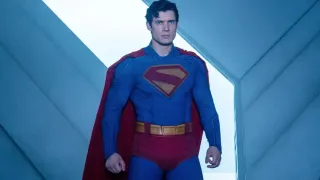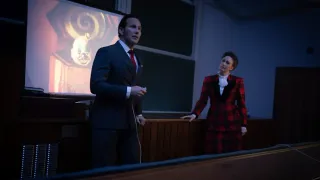
6 hours ago
Welcome to Wplace: a Chaotic, Collaborative Digital Canvas Where Users 'Paint the World'
Wyatte Grantham-Philips and Itzel Luna READ TIME: 5 MIN.
NEW YORK (AP) — In one new corner of the internet, users are invited to “paint the world.” And paint they have. Welcome to wplace — an ever-evolving, gamified global map overflowing with drawings made on a more than 4-trillion-pixel canvas.
Images of Icelandic singer Laufey float over Reykjavík, while tributes for the late Tejano singer Selena Quintanilla surround Corpus Christi, Texas. The crest of San Lorenzo and other soccer clubs fill Buenos Aires. “Squid Game” fanart can be found on the outskirts of Seoul. And Walter White's opening monologue from “Breaking Bad” sits near Albuquerque, New Mexico.
Wplace launched July 21, but the artwork is already overwhelming — ranging from simple stick figures and thin-lettered words, to colorful fanart and highly detailed images users build under online pseudonyms.
“It’s wild, and chaotic and crude,” said Yotam Ophir, a University at Buffalo professor of communication whose research includes analyzing digital spaces. That's part of wplace's appeal, he added, describing the site as a somewhat of a “rebellion” against what the internet has become.
“It’s not going to break Facebook,” he said. “But it’s kind of a reminder that things can be done differently.”
Wplace has garnered more than 10.6 million users worldwide as of Thursday, co-founder Enzo Watanabe told The Associated Press. With that explosion in just over a month, moderation challenges have arisen. Watanabe said via email that the project’s growth “exceeded all expectations” — but acknowledged that “adjusting to the high demand has been challenging.”
The game was developed in Brazil over three months by a single person, he said, and is now run by a team of 46, in addition to volunteers.
Art comes to life, one pixel at a time
New users begin with a small, fixed number of pixels, and more become available every 30 seconds. The more you contribute, the more pixels are available to you — sort of “like a leveling system” seen in video games, said Moira Hembns, a 19-year-old user from Edmonton, Alberta.
Even with bigger pools of pixels, it can take a lot of time to bring map paintings to life. “Every art piece takes me hours to design in advance,” said Hembns. One drawing she recently finished, of a Pokémon named Leafeon in her hometown, took her two days to design outside of wplace — and then another day to build in it, she said.
But Hembns notes that she loves art, and checks the map and places pixels almost every morning now. Muhammad Aliy Fattah bin Yusrizal, a 21-year-old from Malaysia, similarly says wplace has become an outlet for his creativity.
The site “is one of the places that I can express myself,” Fattah said, noting he's mostly contributed art dedicated to his favorite video games and placed atop his home country.
Users from around the world also team up to bring larger projects to life — like “The Neighborhood,” which sits in a corner of Yuma County, Arizona. Real-life resident Krista Rider, 25, started by drawing two homes. It now has over 50, connected by paths, patches of grass and rivers.
“I wanted to do something nice that could lift people up, give them something that they feel like they’re contributing to, whether it’s big or small,” Rider said.
Identity and protest through art
Much of wplace's spaces are filled with an endless array of pop culture references — often intertwined with symbols of local and national identity, protest and other reflections of daily life seen worldwide. In his own time scrolling through wplace's map, Ophir notes he's seen anything from small towns highlighting a restaurant they love, to tributes to local musicians, to broader imagery of political tensions and global conflicts.
“In a way, every person is zooming in on what reflects them and who they are,” Ophir said.
Above Gaza, users have painted Palestinian flags and messages of solidarity amid Israel's ongoing war. Images of war are also seen on the border between Russia and Ukraine — some use their pixels to depict military tanks or planes, while others write messages calling for peace. Washington, D.C., is covered with political messages, many of which focus on President Donald Trump.
Carly Kocurek, associate dean of Lewis College of Science and Letters at Illinois Tech and director of the school’s game design program, says there's a long history of “digital spaces as a places for protest.”
That expressive desire, she said, is “part of why people are looking (at wplace), even if that’s not necessarily what they’re doing there.”
The rise of moderation challenges
While unfiltered chaos is arguably much of the point of wplace's interactive map, the site still outlines general rules barring inappropriate content, bots, disclosing someone else's personal information or painting over other art “using random colors or patterns just to mess things up.” Wplace says it has systems in place to erase drawings that go against its rules — and a report button to flag serious cases.
But users in online discussion threads dedicated to wplace have complained that such moderation is not enforced, or addressed in a timely manner — with some stressing particular concern about hate speech and doxing.
“The amount of moderators they have currently is not really enough for the amount of people that are actually on the site,” says Aaron Hickerson, a 35-year-old user in Germany. “It kind of leaves the system that they have overwhelmed.”
Some say they’ve seen their work disrupted — or, in video game terms, “griefed” — by the same users over and over again. And others have pointed out map art that includes racist words or images, sexually explicit content, vandalized pride flags and Nazi symbols. In response, users have made collective callouts to help cover up such content.
Wplace said it aims to “keep improving” moderation — in addition to looking for technology that will aid server performance and potentially provide more security features.
“The challenge is big, but we are doing our best,” Watanabe said.
Some users have also become used to their art simply being covered up over time. Emily Northrip, a college student in Boston, recently completed a drawing of the superhero character Invincible. When she returned days later, someone else had drawn pupils over his goggles.
But Northrip found the addition funny. Wplace is “a public server,” she said, “If someone wants to draw something over your pixels, they can.”
What's next for wplace?
Jessa Lingel, associate professor of communication at the University of Pennsylvania’s Annenberg School, notes that people have come together to sustain collaborative spaces like Wikipedia or even Archive of Our Own. Still, it takes a lot of work. And “unfortunately, the long arc of internet history does not bend towards self-regulation or responsibility,” she notes.
With the resources required to meet erupting demand, some question whether wplace should keep accepting new submissions forever.
“I definitely don’t want it to stay around forever, because I think it’ll just fall apart if it does,” Hembns said, noting wplace could perhaps create a snapshot capturing the map so far — or pause and open future contributions later, similar to a predecessor, Reddit's now-retired r/place.
Watanabe on Thursday told the AP wplace intends “to continue welcoming new contributions,” as well as host in-platform events.
Regardless of wplace's future, experts like Lingel expect pockets of artistic collaboration to continue emerging online — even they don't attract as much attention.
“Some last longer than others, and some make a splash — and others are just used quietly in a little tiny corner of the internet that most people don’t know about,” she says. “It’s just a matter of who notices them.”
___
Luna reported from Los Angeles.






